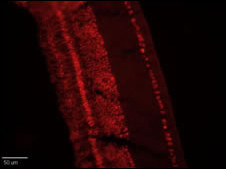CLC4 Antibody (C-term)
Purified Rabbit Polyclonal Antibody (Pab)
- SPECIFICATION
- CITATIONS
- PROTOCOLS
- BACKGROUND

Application
| IF, IHC-P-Leica, WB, E |
|---|---|
| Primary Accession | P51793 |
| Other Accession | P51794, Q61418 |
| Reactivity | Human |
| Predicted | Mouse, Rat |
| Host | Rabbit |
| Clonality | Polyclonal |
| Isotype | Rabbit IgG |
| Calculated MW | 84917 Da |
| Antigen Region | 663-689 aa |
| Gene ID | 1183 |
|---|---|
| Other Names | H(+)/Cl(-) exchange transporter 4, Chloride channel protein 4, ClC-4, Chloride transporter ClC-4, CLCN4 |
| Target/Specificity | This CLC4 antibody is generated from rabbits immunized with a KLH conjugated synthetic peptide between 663-689 amino acids from the C-terminal region of human CLC4. |
| Dilution | IF~~1:10~50 IHC-P-Leica~~1:10~50 WB~~1:1000 E~~Use at an assay dependent concentration. |
| Format | Purified polyclonal antibody supplied in PBS with 0.09% (W/V) sodium azide. This antibody is prepared by Saturated Ammonium Sulfate (SAS) precipitation followed by dialysis against PBS. |
| Storage | Maintain refrigerated at 2-8°C for up to 2 weeks. For long term storage store at -20°C in small aliquots to prevent freeze-thaw cycles. |
| Precautions | CLC4 Antibody (C-term) is for research use only and not for use in diagnostic or therapeutic procedures. |
| Name | CLCN4 |
|---|---|
| Function | Strongly outwardly rectifying, electrogenic H(+)/Cl(-)exchanger which mediates the exchange of chloride ions against protons (PubMed:18063579, PubMed:23647072, PubMed:25644381, PubMed:27550844, PubMed:28972156). The CLC channel family contains both chloride channels and proton-coupled anion transporters that exchange chloride or another anion for protons (PubMed:29845874). The presence of conserved gating glutamate residues is typical for family members that function as antiporters (PubMed:29845874). |
| Cellular Location | Early endosome membrane {ECO:0000250|UniProtKB:P51794}; Multi-pass membrane protein. Late endosome membrane; Multi-pass membrane protein. Endoplasmic reticulum membrane; Multi-pass membrane protein. Lysosome membrane; Multi-pass membrane protein. Recycling endosome membrane; Multi-pass membrane protein. Note=Localizes to late endosome membrane, lysosome membrane and recycling endosome membrane in the presence of CLCN3 |
| Tissue Location | Abundant in skeletal muscle and also detectable in brain and heart |

Thousands of laboratories across the world have published research that depended on the performance of antibodies from Abcepta to advance their research. Check out links to articles that cite our products in major peer-reviewed journals, organized by research category.
info@abcepta.com, and receive a free "I Love Antibodies" mug.
Provided below are standard protocols that you may find useful for product applications.
Background
The CLCN family of voltage-dependent chloride channel genes comprises nine members (CLCN1-7, Ka and Kb) which demonstrate quite diverse functional characteristics while sharing significant sequence homology. Chloride channel 4 has an evolutionary conserved CpG island and is conserved in both mouse and hamster. This gene is mapped in close proximity to APXL (Apical protein Xenopus laevis-like) and OA1 (Ocular albinism type I), which are both located on the human X chromosome at band p22.3. The physiological role of chloride channel 4 remains unknown but may contribute to the pathogenesis of neuronal disorders.
References
Wang, T., et al., Gastroenterology 126(4):1157-1166 (2004).
Lamb, F.S., et al., J. Mol. Cell. Cardiol. 31(3):657-666 (1999).
Dinulos, M.B., et al., Genomics 35(1):244-247 (1996).
Schnur, R.E., et al., Hum. Genet. 95(5):594-595 (1995).
van Slegtenhorst, M.A., et al., Hum. Mol. Genet. 3(4):547-552 (1994).
If you have used an Abcepta product and would like to share how it has performed, please click on the "Submit Review" button and provide the requested information. Our staff will examine and post your review and contact you if needed.
If you have any additional inquiries please email technical services at tech@abcepta.com.













 Foundational characteristics of cancer include proliferation, angiogenesis, migration, evasion of apoptosis, and cellular immortality. Find key markers for these cellular processes and antibodies to detect them.
Foundational characteristics of cancer include proliferation, angiogenesis, migration, evasion of apoptosis, and cellular immortality. Find key markers for these cellular processes and antibodies to detect them. The SUMOplot™ Analysis Program predicts and scores sumoylation sites in your protein. SUMOylation is a post-translational modification involved in various cellular processes, such as nuclear-cytosolic transport, transcriptional regulation, apoptosis, protein stability, response to stress, and progression through the cell cycle.
The SUMOplot™ Analysis Program predicts and scores sumoylation sites in your protein. SUMOylation is a post-translational modification involved in various cellular processes, such as nuclear-cytosolic transport, transcriptional regulation, apoptosis, protein stability, response to stress, and progression through the cell cycle. The Autophagy Receptor Motif Plotter predicts and scores autophagy receptor binding sites in your protein. Identifying proteins connected to this pathway is critical to understanding the role of autophagy in physiological as well as pathological processes such as development, differentiation, neurodegenerative diseases, stress, infection, and cancer.
The Autophagy Receptor Motif Plotter predicts and scores autophagy receptor binding sites in your protein. Identifying proteins connected to this pathway is critical to understanding the role of autophagy in physiological as well as pathological processes such as development, differentiation, neurodegenerative diseases, stress, infection, and cancer.




